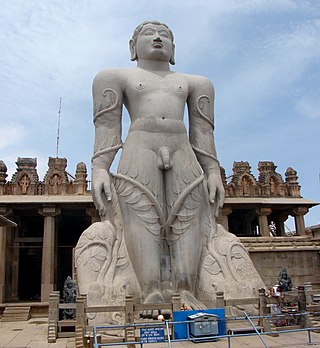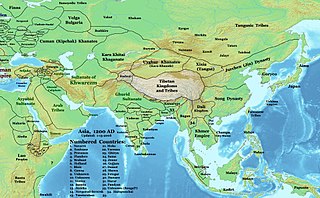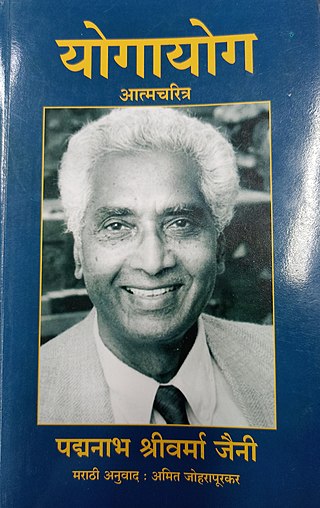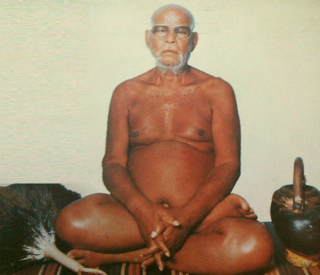
Kannada, previously also known as Canarese, is a Dravidian language spoken predominantly by the people of Karnataka in southwestern India, with minorities in all neighbouring states. It has around 44 million native speakers, and is additionally a second or third language for around 15 million non-native speakers in Karnataka.

Sambhaji, also known as Shambhuraje was the second Chhatrapati of the Maratha Empire, ruling from 1681 to 1689. He was the eldest son of Shivaji, the founder of the Maratha Empire. Sambhaji's rule was largely shaped by the ongoing wars between the Maratha Empire and the Mughal Empire, as well as other neighbouring powers such as the Abyssinians of Janjira, Wadiyars of Mysore and the Portuguese Empire in Goa. After Sambhaji's death, his brother Rajaram I succeeded him as the next Chhatrapati and continued the Mughal–Maratha Wars.
Saitwal is a Digambara Jain community of Maharashtra. Swahitwal means that they work for the benefit of their inner self (Swa+hit+wal).

Vinayaka Krishna Gokak, abbreviated in Kannada as Vi. Kru. Gokak, was an Indian writer in the Kannada language and a scholar of English and Kannada literatures. He was the fifth writer to be honoured with the Jnanpith Award in 1990 for Kannada language, for his epic Bharatha Sindhu Rashmi. Bharatha Sindhu Rashmi deals with the Vedic age and is perhaps the longest epic narrative in any language in the 20th century. In 1961, Gokak was awarded the Padma Shri from the Government of India for Dyava Prithvi.

Bahubali, a much revered figure among Jains, was the son of Rishabadeva and the brother of Bharata Chakravartin. He is said to have meditated motionless for a 12 years in a standing posture (kayotsarga) and that during this time, climbing plants grew around his legs. After his 12 year of meditation, Bahubali is said to have attained omniscience.
Shivakotiacharya, a writer of the 9th-10th century, is considered the author of didactic Kannada language Jain text Vaddaradhane. A prose narrative written in pre-Old-Kannada, Vaddaradhane is considered the earliest extant work in the prose genre in the Kannada language. Scholars are, however, still divided about when exactly the text was written, with claims ranging from before the 6th century to the 10th century.

Hoysala literature is the large body of literature in the Kannada and Sanskrit languages produced by the Hoysala Empire (1025–1343) in what is now southern India. The empire was established by Nripa Kama II, came into political prominence during the rule of King Vishnuvardhana (1108–1152), and declined gradually after its defeat by the Khalji dynasty invaders in 1311.
Hampa Nagarajaiah, popularly known by his pen name Hampanā, is an Indian scholar in Kannada language and Jainism. He was born at Hampasandra Village located in Gowribidanur taluk, Chikkaballapura District in the Indian state of Karnataka. Hampanā is married to Kamala Hampana who also a veteran littérateur.
Colette Caillat was a French professor of Sanskrit and comparative grammar. She was also one of the world's leading Jain scholars.
Jain literature refers to the literature of the Jain religion. It is a vast and ancient literary tradition, which was initially transmitted orally. The oldest surviving material is contained in the canonical Jain Agamas, which are written in Ardhamagadhi, a Prakrit language. Various commentaries were written on these canonical texts by later Jain monks. Later works were also written in other languages, like Sanskrit and Maharashtri Prakrit.

Vasudev Vishnu Mirashi (1893–1985) was a Sanskrit scholar and a prominent Indologist of the 20th century who hailed from Maharashtra, India. He was an expert of his times on stone and copper inscriptions and the coinage of ancient India. For his contributions to Indian history he was honoured with the title Mahamahopadhyaya by the British Indian Government in 1941. He was also awarded Padma Bhushan in 1975 by the President of India.

Jagdish Chandra Jain was a scholar, indologist, educationist, writer, and freedom fighter during the freedom struggle of India. He authored over 80 books on a variety of subjects, including Jain philosophy, Prakrit literature, and Hindi textbooks for children. Jain was the chief prosecution witness in Gandhi's murder trial. He repeatedly tried to warn the government of the conspiracy to assassinate Mahatma Gandhi, which became to known to him after Madan Lal Pahwa, a Punjabi refugee and one of the conspirators of the murder of Mahatma Gandhi, confided to him of their plan. Jain's attempts to warn the government met deaf ears. He recounted his personal experiences in two books: I Could Not Save Bapu and The Forgotten Mahatma. He died from cardiac arrest in July 1993 in Bombay at the age of 84.
Asaga was a 9th-century Digambara Jain poet who wrote in Sanskrit and Kannada language. He is most known for his extant work in Sanskrit, the Vardhamana Charitra. This epic poem which runs into eighteen cantos was written in 853 CE. It is the earliest available Sanskrit biography of the last tirthankara of Jainism, Mahavira. In all, he authored at least eight works in Sanskrit. In Kannada, none of his writings, including the Karnataka Kumarasambhava Kavya that have been referenced by latter day poets have survived.

Sukhlal Sanghvi, also known as Pandit Sukhlalji, was a Jain scholar and philosopher. He belonged to the Sthanakvasi sect of Jainism. Pandit Sukhlal lost his eyesight at the age of sixteen on account of smallpox. However, he persisted and became profoundly versed in Jain logic and rose to become a professor at Banaras Hindu University. Paul Dundas calls him one of the most incisive modern interpreters of Jain philosophy. Dundas notes that Sanghavi represents what now seems to be a virtually lost scholarly and intellectual world. He was a mentor for famous Jain scholar Padmanabh Jaini. During his lifetime he won such awards as the Sahitya Akademi Award and won recognition from the Government of India by getting Padma Bhushan award. Sukhlalji was also known as Pragnachaksu because he was so vastly learned despite being visually disabled.

Padmanabh Shrivarma Jaini was an Indian born scholar of Jainism and Buddhism, living in Berkeley, California, United States. He was from a Digambar Jain family; however he was equally familiar with both the Digambara and Svetambara forms of Jainism. He has taught at the Banaras Hindu University, the School of Oriental and African Studies (SOAS), the University of Michigan at Ann Arbor and at the University of California at Berkeley, from which he retired in 1994. Jaini was the author of several books and papers. His best known work is The Jaina Path of Purification (1979). Some of his major articles have been published under these titles: The Collected Papers on Jaina Studies (2000) and Collected Papers on Buddhist Studies (2001). He died on 25 May 2021 at Berkeley at age 97.

About 25,000 inscriptions found in Karnataka and states near by belongs to Kannada rulers like Kadambas, Western Ganga Dynasty, Rashtrakuta, Chalukya, Hoysala and Vijayanagara Empire. Many inscriptions related to Jainism are unearthed. The inscriptions generally found are on stone (Shilashasana) or copper plates (Tamarashasana). The Kannada inscriptions found on historical Hero Stone, coin and temple wall, piller, tablet and rock edict. These Inscription have contributed towards Kannada literature and helped to classify as Proto Kannada, Pre Old Kannada, Old Kannada, Middle Kannada and New Kannada. Inscriptions depicts culture, tradition and prosperity of those era. The worldwide recognized literature Ramayana and Mahabharata are transferred through generation by these Inscription Hazara Rama Temple and Aranmula Parthasarathy Temple are the best example.

Acharya Deshbhushan was a Digambara Jain Acharya of 20th century who composed and translated many Kannada scriptures to Hindi and Sanskrit. He initiated and elevated several Jain monks and nuns like Shwetpichhi Acharya Vidyananda ji and Gyanmati Mataji. He is renowned for his remarkable translations of Kannada scriptures to sanskrit and Hindi. He is the first Digambara Acharya to visit and address the Indian Parliament in the year 1974 along with the Prime Minister Indira Gandhi.

Doddabele Lakshmi Narasimhachar was a Kannada linguist, grammarian, lexicographer, writer, literary critic and editor who taught at the Department of Kannada Language Studies, University of Mysore between 1932 - 1962. His knowledge of Halegannada helped him in reading ancient epigraphic records. He authored four books in Kannada, edited about nine volumes, penned eleven prefaces, wrote nearly hundred articles across three decades, seven monographs in English and outlined introductions to four Kannada works. He presided over the forty first Kannada Sahitya Sammelan held at Bidar in 1960. He was the recipient of the Kannada Rajyotsava Award from the Mysore State. In 1969, his alma mater - University of Mysore bestowed on him an Honorary Doctorate in recognition of a lifetime contribution to the world of Kannada studies.

Kamala Hampana is an Indian writer in Kannada language and Jainism. She was born at Devanahalli, Bangalore, Karnataka. She worked as a scholar, a professor, and a follower of ancient Archaic works. She has undertaken serious study and research in various genres of Kannada literature and has developed some of the most serious ideas of various genres.

B.S Sannaiah was an Indian writer in Kannada language. He was born in Bhoganahalli, Piriyapatna talluk, Mysore, Karnataka. He worked as a Editor, Textual critic and a follower and protector of ancient Archaic works & manuscripts. He had undertaken study and research in various manuscript works in Kannada & jain literature and made some of the major contributions in the field.















